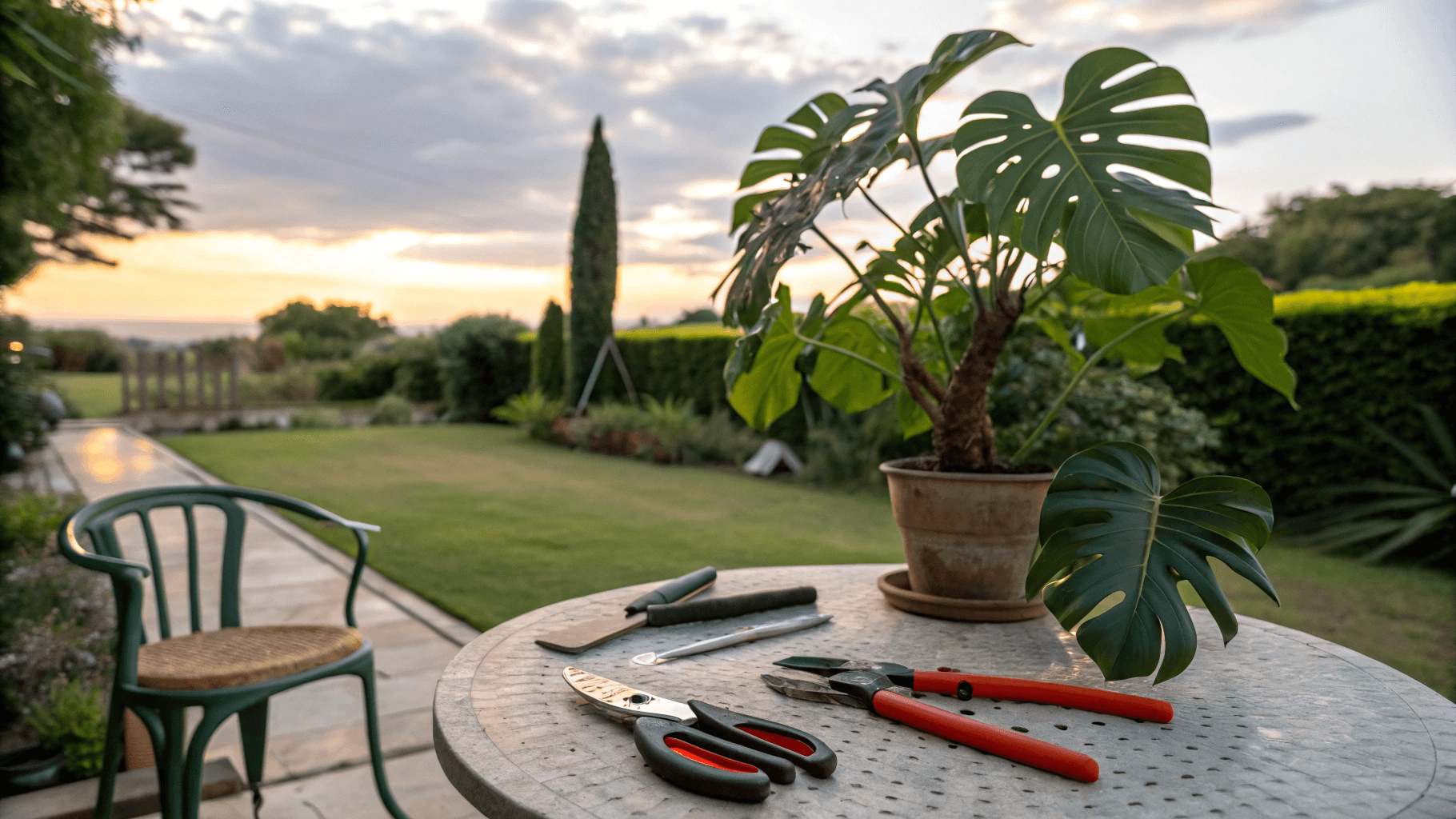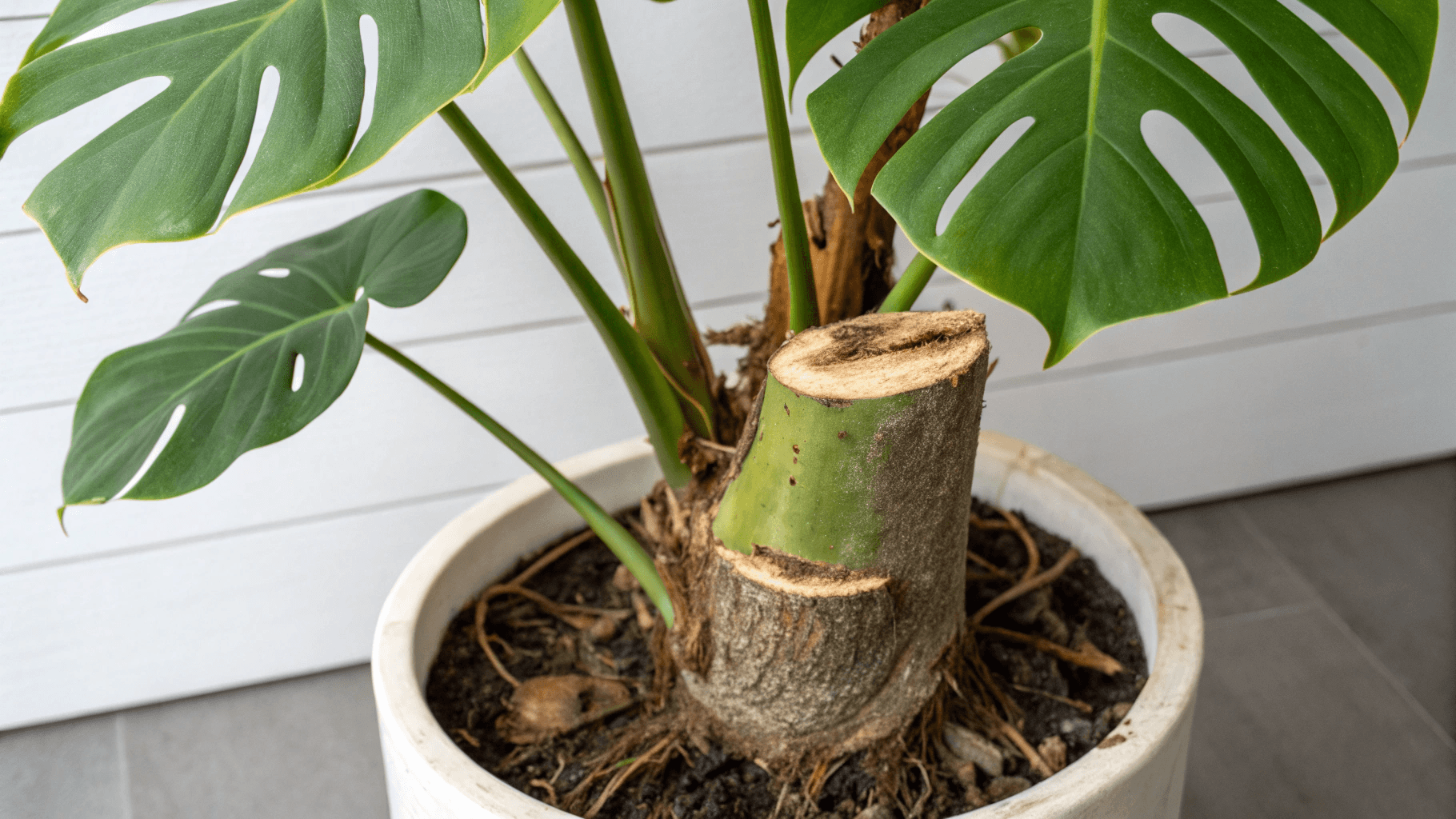These tropical beauties grow fast and love to take up space, but without regular pruning, they can quickly outgrow their spot and lose that elegant shape.
Pruning Monstera regularly is key to maintaining healthy growth, proper size, and strong vitality. Done correctly, pruning helps your Monstera grow fuller, with bigger leaves and stronger stems. Done the wrong way, though, it can lead to drooping leaves, brown edges, or even infection.
So, how do you prune a Monstera the right way without damaging it?
Here’s the short answer: use clean, sharp tools, cut just above a node or stem joint, and always prune during its active growing season (spring or summer).
Table of Contents
Why Pruning Matters for Your Monstera
Pruning is one of the easiest and most effective ways to help your Monstera thrive. When you remove old, yellowing, or damaged leaves, you’re allowing the plant to redirect its energy toward new, healthy growth.
Here are the main reasons pruning matters:
- Encourages healthy growth: Cutting away weak stems or crowded leaves boosts airflow and light penetration, reducing the chance of mold or pests.
- Controls size: Monstera can easily grow several feet tall and wide. Strategic pruning keeps them manageable for indoor spaces.
- Improves aesthetics: Pruning helps you shape your plant, whether you want that wild jungle look or a tidy, symmetrical display.
- Prevents legginess: If your Monstera starts stretching toward light and losing leaves at the base, pruning can stimulate new growth lower on the stem.
When to Start Pruning Monstera
Timing is everything when it comes to pruning. The best time to prune your Monstera is during its active growing season – spring and early summer.

During these months, the plant’s metabolism is high, so it heals faster and produces new growth more efficiently. You’ll notice that new leaves appear regularly, which means your Monstera has plenty of energy to recover from trimming.
Avoid heavy pruning in fall or winter.
That’s when Monstera enter a semi-dormant phase, slowing their growth. If you cut too much during this period, the plant may struggle to heal and could even develop infections or rot at the cut sites.
That said, you can always remove dead or yellowing leaves year-round, just keep major cuts for spring.
Tools and Preparation
Before you start snipping away, make sure you have the right tools and setup. Clean tools mean healthy cuts and healthy plants.

What You’ll Need:
- Sharp pruning shears or scissors: Dull blades can crush stems instead of cutting cleanly, increasing the risk of infection.
- Rubbing alcohol or disinfectant: Wipe your blades before and after use to prevent spreading bacteria or fungus.
- Gloves (optional): Monstera sap can irritate sensitive skin.
- Clean workspace: Lay down paper towels or a mat to catch plant debris.
TIP: Always sanitize your tools between cuts if you’re removing diseased or damaged leaves. It’s a small step that prevents big problems later.
Step-by-Step Pruning Monstera the Right Way
Let’s get to the heart of it. Here’s how to prune your Monstera without damaging it:
Step 1: Inspect Your Plant
Start by examining your Monstera carefully. Identify:
- Dead, yellowing, or drooping leaves
- Overgrown stems that look messy or unbalanced
- Long aerial roots that you might want to trim (optional)
Mark the areas you plan to cut. A quick visual plan helps prevent over-pruning.
Step 2: Locate the Nodes
A node is the small bump or line on the stem where leaves, roots, or new stems grow. Always cut just above a node when pruning; this encourages new growth from that spot.
Avoid cutting too close to the node or too far away. A clean, diagonal cut about half an inch above the node works best.
Step 3: Make the Cut
Using your clean shears, cut decisively and smoothly. Don’t saw through the stem or twist it off. If you’re pruning large stems, you might want to support the plant with one hand while cutting with the other to prevent tearing.
Step 4: Clean Up and Care
Once you’ve made all your cuts:
- Remove any debris from the soil surface.
- Wipe away sap or moisture on stems.
- Optionally, apply a bit of cinnamon powder to large cuts; it acts as a natural antifungal.
Then water your Monstera lightly and keep it in bright, indirect light to help it recover.
Shaping Your Monstera vs. Thinning It
There are two main approaches to pruning a Monstera: shaping and thinning. Both serve different purposes, and knowing the difference will help you get the look you want.
Shaping
Shaping focuses on the overall appearance of your plant. You’re cutting stems strategically to create a fuller, more balanced silhouette.
For example, if your Monstera leans heavily to one side or looks top-heavy, prune the longest stems on that side. Encourage growth from the opposite side by leaving a few healthy nodes there.
Thinning
Thinning is all about improving airflow and reducing overcrowding. Remove stems that overlap or block light from reaching lower leaves.
This is especially useful for mature Monstera that have become dense or leggy.
Remember: Less is often more. It’s better to prune gradually over time than to cut off too much in one go.
What to Do with the Cuttings (Propagate!)
Here’s the fun part: you don’t have to throw those beautiful Monstera cuttings away! You can easily propagate them and grow new plants to share, gift, or keep.

How to Propagate a Monstera Cutting:
- Choose a healthy cutting with at least one node and one leaf.
- Place it in a jar of clean water, ensuring the node is submerged.
- Change the water every few days to prevent bacteria buildup.
- Keep the jar in bright, indirect light.
- In a few weeks, you’ll notice roots forming! Once they’re a few inches long, transplant the cutting into soil.
Propagation is one of the most rewarding parts of monstera care; it’s like getting a brand-new plant for free.
For more on this and other ways to nurture your plant’s growth, see different Monstera varieties; you might even find a few new ones to propagate next.
Common Mistakes and How to Recover From Them
Even the most careful plant parents make mistakes sometimes. Here are a few to watch out for and how to fix them.

Over-pruning
Cutting too many leaves at once can shock your Monstera and slow its recovery. Stick to removing no more than 20–25% of the plant at a time.
Fix: Keep your plant in a stable environment with good light and humidity. Avoid fertilizing for a few weeks until new growth appears.
Cutting in the Wrong Spot
If you cut below a node, that section won’t regrow, and the stem may die back.
Fix: Next time, always cut just above a node, where new growth can emerge.
Ignoring Tool Hygiene
Dirty tools spread disease and can cause black or mushy spots on fresh cuts.
Fix: Disinfect your shears before and after pruning. If infection occurs, remove the affected part and clean the wound.
Neglecting Light and Water After Pruning
A freshly pruned Monstera needs consistent care to bounce back.
Fix: Place it in bright, indirect light and water moderately. Avoid sudden changes in location or temperature.
Conclusion
Pruning your Monstera doesn’t have to be intimidating. With the right timing, tools, and technique, you can shape your plant beautifully without causing harm. Remember:
- Prune in spring or early summer.
- Always use clean, sharp tools.
- Cut just above the node.
- Propagate those cuttings, you’ll thank yourself later.
Whether you’re aiming for a neat, compact Monstera or a wild, jungle-style statement plant, regular pruning keeps it healthy, balanced, and thriving for years.


 ChatGPT
ChatGPT
 Perplexity
Perplexity
 Claude
Claude
Leave a Reply